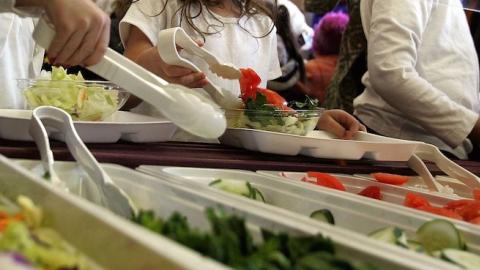America’s 50 million public school students are now back in the classroom, but a food fight raged all summer over the practicality of new standards for healthier fare in the cafeteria. Specifically, how do schools persuade the 37 million students who receive meals through the National School Lunch Program to consume more nutritious, lower-calorie foods and beverages, without turning them off altogether?
The skirmish is over the implementation of the Healthy, Hunger-Free Kids Act of 2010, which revamped nutrition standards in school cafeterias to counter stubbornly high obesity rates among children and adolescents. Critics say the act’s requirements for more fruits, vegetables, and whole grains have repelled more than a million kids and left an estimated $3.8 million of produce to be wasted each day. The School Nutrition Association, an organization representing 55,000 school cafeterias, chimes in that these new requirements are too expensive and cause 3% of the students participating in the program to stop eating lunch at school. Some in Congress have asked the National School Lunch Program to give cash-strapped school districts another year to implement the higher standards. Even the White House has weighed in, with First Lady Michelle Obama fighting these proposals.
These factions all think they know what’s best, but ultimately their bickering may be pointless. Here is why: Despite all the barbs and accusations, school menus are actually being revamped for the better, quietly and without pointing it out to the finicky target audience. Consider the example of Sodexo Inc., the $8 billion U.S. unit of the French company that supplies U.S. school cafeterias serving 2 million lunches daily.
Instead of resisting the movement to feed our children more nutritious foods, Sodexo ’s efforts tell a different and more encouraging story. In 2009 the company signed on with the Alliance for a Healthier Generation, a joint initiative of the American Heart Association and the William J. Clinton Foundation that seeks to significantly reduce U.S. childhood obesity by 2015. The company also pledged at the First Lady’s Partnership for a Healthier America Summit in March 2014 to add more nutritious options to its vending and K-12 lunchroom programs, and to redesign or rearrange lunchrooms in its K-12 accounts by 2016 to encourage kids to choose healthier foods.
Since 2009 the cafeteria supplier has been tweaking recipes and marketing its healthier lunchroom offerings with a sizzle worthy of mall food courts. This initiative embraces principles from Cornell University’s well-regarded Smarter Lunchrooms movement, which shows schools how to improve students’ cafeteria choices through low- or no-cost strategies. These include making lower-fat white milk easier to reach than chocolate milk, giving healthier products more tempting names like “Bionic Carrots,” and offering new product samples to get children to accept healthier versions.
Sodexo has also worked with many of its supply-chain partners—supplying both ingredients and ready-to-eat items—to overhaul recipes and introduce healthier versions of favorite foods. These new menu items are kid-tested and refined before they are rolled out to schools. For example, Sodexo and Rich Products Corp. developed a whole-wheat pizza crust that was a hit with child testing panels and in the lunchroom. It collaborated with ConAgra to solve the whole wheat pasta disintegration problem. Using ConAgra’s Ultragrain, a whole wheat flour that mimics the taste and texture of real white flour, the reformulated pasta required a different cooking method. Sodexo showed lunchroom workers how to prepare it.
Lunchrooms that Sodexo supplies also offer a whole-grain version of the popular Scoops corn chips made by Frito-Lay, a division of PepsiCo. These not only deliver more whole grains, but also serve as a stiffer spoon. That reduces breakage. Sodexo has also distributed the whole grain version of the popular Goldfish crackers from Pepperidge Farm. Cafeterias are using the popular snack to increase sales of healthy soup; children can’t buy the Goldfish crackers separately, but only with soup.
All this activity follows a major initiative led by the Alliance for a Healthier Generation to replace sugary beverages in school vending machines. To date, more than 90% of all schools have replaced such products and now offer better-for-you versions such as bottled water and diet beverages.
The impact on child nutrition looks promising. In one Smarter Lunchroom pilot program, 21% more vegetables were eaten and fruit consumption rose by 14%, following an initial decline in the number of meals served. In contrast to School Nutrition Association statistics, lunchroom waste did not go up one bit after the healthier food tactics were launched. Moreover, the new foods have been good for business. Following an initial decline in the number of meals served due to the implementation of the Healthy and Hunger-Free Kids Act, Sodexo’s sales to schools this year are as strong as previously recorded.
Purists may scoff at letting the Big Food bad boys into the lunchroom. But who better to change kids’ mindsets than large food and restaurant companies, with their much-maligned covens of food scientists searching for “bliss points,” their testing panels, and their clever marketing programs? It is clear that improving the nutritional quality of foods for kids is not only the right thing to do but also a growth opportunity for food companies. And it helps them generate a loyal following for their healthier products. More food companies need to be involved, and child nutrition activists need to engage them to address the obesity crisis.
So let’s continue to follow the example of Sodexo and other companies that have committed to better nutrition for schoolchildren. With a little tweaking and a new image, the lunch tray outcasts can become hip and attractive, and gain more fans in the school cafeteria and beyond.















